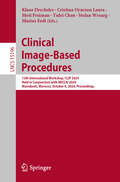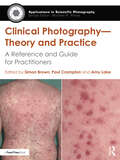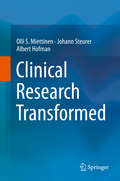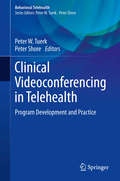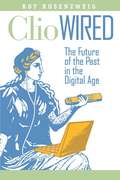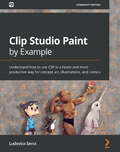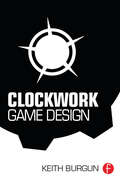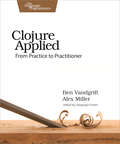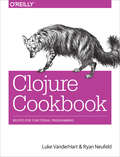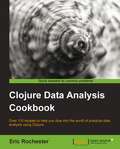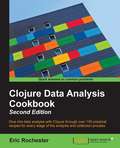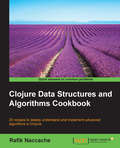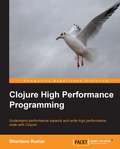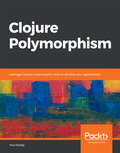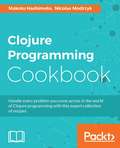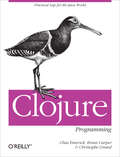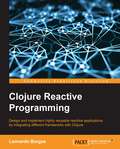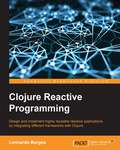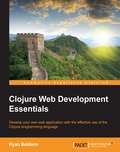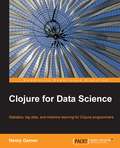- Table View
- List View
Clinical Image-Based Procedures: 11th Workshop, CLIP 2022, Held in Conjunction with MICCAI 2022, Singapore, September 18, 2022, Proceedings (Lecture Notes in Computer Science #13746)
by Cristina Oyarzun Laura Raj Shekhar Stefan Wesarg Klaus Drechsler Marius Erdt Marius George Linguraru Yufei ChenThis book constitutes the proceedings of the 11th Workshop on Clinical Image-Based Procedures, CLIP 2022, which was held in conjunction with MICCAI 2022, in Singapore in September 2022. The 9 full papers included in this book were carefully reviewed and selected from 12 submissions. They focus on the applicability of basic research methods in the clinical practice by creating holistic patient models as an important step towards personalized healthcare.
Clinical Image-Based Procedures: 13th International Workshop, CLIP 2024, Held in Conjunction with MICCAI 2024, Marrakesh, Morocco, October 6, 2024, Proceedings (Lecture Notes in Computer Science #15196)
by Cristina Oyarzun Laura Stefan Wesarg Klaus Drechsler Marius Erdt Yufei Chen Moti FreimanThis book constitutes the proceedings of the 13th Workshop on Clinical Image-Based Procedures, CLIP 2024, held in conjunction with the 27th International conference on Medical Image Computing and Computer Assisted Intervention, MICCAI 2024, in Marrakesh, Morocco in October 2024. The 9 full papers included in this book were carefully reviewed and selected from 11 submissions. They deal with Clinical image-based procedures, focusing on holistic patient models as an important step towards personalized healthcare.
Clinical Information Systems: Overcoming Adverse Consequences
by Dean F. Sittig Joan S. AshAs the number of healthcare organizations beginning to implement clinical information systems grows, the number of unanticipated and unintentional consequences inevitably increases as well. While existing research suggests that much good can come from clinicians entering orders directly, errors or other unintended consequences related to technology may arise. Ideal for both clinicians and information technology professionals, Clinical Information Systems: Overcoming Adverse Consequences helps fledgling organizations better prepare for the inevitable challenges and obstacles they will face upon the implementation of such systems. Based on the research and findings from the Provider Order Entry Team from the Oregon Health & Science University, this book discusses the nine categories of unintended adverse consequences that occurred at many of the leading medical centers during their implementation and maintenance of a state-of-the-art clinical information system. It goes on to present the best practices they identified to help organizations overcome these obstacles.
Clinical Photography — Theory and Practice: A Reference and Guide for Practitioners (Applications in Scientific Photography)
by Simon Brown Paul Crompton Amy LakeThis is an authoritative and comprehensive reference for understanding clinical photography and improving the reader's ability to hone their skills and knowledge.The book first explores the rationale for clinical photography before going on to provide a practical guide to equipment selection, standardized techniques and digital workflows in a range of settings, from the professional studio to the DIY enthusiast, whilst also including telemedicine.Written and edited by three of the UK’s most experienced and qualified clinical photographers, with additional chapters written by other specialists, it is richly illustrated with numerous example images and suggested protocols and covers basic photographic theory, suitable equipment, digital image workflow and a major chapter on standardized representational photography, the cornerstone of professional clinical photography.Some medical specialties are covered in detail, including dermatology, dental and oral medicine, pediatrics, orthopedics, telemedicine and photography in surgery and the operating room. As well as a practical guide to clinical photography, the book also discusses the legal, moral and ethical contexts within which photography in medicine operates and, for the first time, explores the societal, cultural and religious factors for practicing in today’s digitally literate, multicultural world.This book will provide a valuable resource for biomedical photography students, practitioners and clinicians interested in developing their photography skills and applying them to medicine.
Clinical Research Transformed
by Olli S. Miettinen Johann Steurer Albert HofmanIn this Information Age, the practices of clinical medicine should no longer be based on what clinical doctors actively know. Rather, all of the importantly practice-relevant knowledge should not only already exist but also be codified in cyberspace, in directly practice-guiding 'expert systems' -- for the benefit of both doctors and patients everywhere. Each of these systems (discipline-specific) would, prompted by a particular type of case presentation, present the doctor a questionnaire specific to cases of the type at issue, and document the doctor's answers to the questions. If at issue would be a case of complaint about a (particular type of) sickness, the system would translate the resulting diagnostic profile of the case into the corresponding probabilities of the illnesses to be considered. Similarly, if at issue would be an already-diagnosed case of a particular illness, the system would ask about, and record, the relevant elements in the prognostic profile of the case and then translate this profile into the probabilities of various outcomes to be considered, probabilities specific to the choice of treatment and prospective time in addition to that profile. And besides, these systems would analogously address the causal origin -- etiogenesis -- of cases of particular types of illness. While the requisite knowledge-base for these systems -- notably for the probabilities in them -- has not been addressed by such 'patient-oriented' clinical research as has been conducted (very extensively) up to now, this book delineates the nature of the suitably-transformed research (gnostic). The critically-transformative innovation in the research is the studies' focus on Gnostic Probability Functions -- dia-, etio-, and prognostic -- in the framework of logistic regression models. This book also presents a vision of how this critically-transformative research would most expeditiously be provided for and also conducted, among select sets of academic teaching hospitals.
Clinical Videoconferencing in Telehealth: Program Development and Practice (Behavioral Telehealth)
by Peter W. Tuerk Peter ShoreResearch findings and dissemination are making healthcare more effective. Electronic health records systems and advanced tools are making care delivery more efficient. Legislative reforms are striving to make care more affordable. Efforts still need to be focused on making healthcare more accessible. Clinical Videoconferencing in Telehealth takes a comprehensive and vital step forward in providing mental health and primary care services for those who cannot make traditional office visits, live in remote areas, have transportation or mobility issues or have competing demands. Practical, evidence-based information is presented in a step by step format at two levels: for administrators, including information regarding selecting the right videoconferencing technology, navigating regulatory issues, policy temples, boilerplate language for entering into care agreements with other entities and practical solutions to multisite programming; and for clinicians, including protocols for safe, therapeutically sound practice, informed consent and tips for overcoming common technical barriers to communication in clinical videoconferencing contexts. Checklists, tables, templates, links, vignettes and other tools help to equip professional readers for providing safe services that are streamlined and relevant while avoiding guesswork, false starts and waste. The book takes a friendly-mentor approach to communication in areas such as: Logistics for administrators: Clinical videoconferencing infrastructures and technologies Policy development, procedures and tools for responsible and compliant programming Navigating issues related to providing services in multiple locations Protocols for clinicians: The informed consent process in clinical videoconferencing Clinical assessment and safety planning for remote services Minimizing communication disruption and optimizing the therapeutic alliance Clinical Videoconferencing in Telehealth aptly demonstrates the promise and potential of this technology for clinicians, clinic managers, administrators and others affiliated with mental health clinical practices. It is designed to be the comprehensive "one-stop" tool for clinical videoconferencing service development for programs and individual clinicians.
Clinical and Biomedical Engineering in the Human Nose: A Computational Fluid Dynamics Approach (Biological and Medical Physics, Biomedical Engineering)
by Jiyuan Tu Kiao Inthavong Narinder Singh Eugene WongThis book explores computational fluid dynamics in the context of the human nose, allowing readers to gain a better understanding of its anatomy and physiology and integrates recent advances in clinical rhinology, otolaryngology and respiratory physiology research. It focuses on advanced research topics, such as virtual surgery, AI-assisted clinical applications and therapy, as well as the latest computational modeling techniques, controversies, challenges and future directions in simulation using CFD software. Presenting perspectives and insights from computational experts and clinical specialists (ENT) combined with technical details of the computational modeling techniques from engineers, this unique reference book will give direction to and inspire future research in this emerging field.
Clio Wired: The Future of the Past in the Digital Age
by Roy RosenzweigIn these visionary essays, Roy Rosenzweig charts the impact of new media on teaching, researching, preserving, presenting, and understanding history. Negotiating between the "cyberenthusiasts" who champion technological breakthroughs and the "digitalskeptics" who fear the end of traditional humanistic scholarship, Rosenzweig re-envisions academic historians' practices and professional rites while analyzing and advocating for amateur historians' achievements. While he addresses the perils of "doing history" online, Rosenzweig eloquently identifies the promises of digital work, detailing innovative strategies for powerful searches in primary and secondary sources, the increased opportunities for dialogue and debate, and, most of all, the unprecedented access afforded by the Internet. Rosenzweig draws attention to the opening up of the historical record to new voices, the availability of documents and narratives to new audiences, and the attractions of digital technologies for new and diverse practitioners. Though he celebrates digital history's democratizing influences, Rosenzweig also argues that we can only ensure the future of the past in this digital age by actively resisting the efforts of corporations to put up gates and profit from the Web.
Clip Studio Paint by Example: Understand how to use CSP in a faster and more productive way for concept art, illustrations, and comics
by Ludovico SerraGet up to speed with the essential tools and workflows for creating a professional portfolio using Clip Studio PaintKey FeaturesExplore the different art tools available for creating your own illustrations, comics, and animationsLearn how to make best use of Clip Studio Paint by implementing it in real-world scenariosUse Clip Studio Paint to leverage your artistic skills and create a portfolioBook DescriptionClip Studio Paint is powerful art software that can help you create artistic work with its in-built material organizer, 3D integration, and group work features. It also provides other features that can speed up the workflow of illustrators, concept artists, and comic artists. With Clip Studio Paint by Example, you'll learn how to use CSP effectively for a wide variety of artistic purposes. The book starts by helping you create the right workspace for concept art, illustration, and comics. You'll create a brush, set up a canvas, and develop an auto-auction. Along with covering how to work with CS Modeler that comes bundled with CSP, this book shows you how to import and rig characters easily. You'll then create reusable changeable scenes and a 3D human character in Blender before exploring concept art, illustrations, comics, and how to create your own portfolio. The book features a glossary with brief explanations of all the main CSP functions. The focus of the book is not on drawing or painting but on helping you enhance your artistic skills using Clip Studio Paint to create an impressive portfolio. By the end of this book, you'll be able to use the impressive capabilities of CSP to create beautiful digital art in a productive way.What you will learnExplore Clip Studio Paint and its use casesBecome familiar with the Clip Studio ecosystem for solving your artistic problemsImplement the CS Modeler and import and rig characters easilyCreate reusable and editable scenes and props using CS ModelerBuild a 3D human character using the Blender softwareSet up your workspace using CSP toolsCreate portfolios for your comics, illustrations, and concept artWho this book is forThis Clip Studio Paint book goes beyond the technical stuff that helps beginner-level as well as intermediate artists who are new to working in a digital environment and need a more streamlined and seamless workflow relating to illustrations, concept art, and comics in Clip Studio Paint. No prior knowledge of Clip Studio Paint is required to get started with this book.
Clockwork Game Design
by Keith BurgunOnly by finding and focusing on a core mechanism can you further your pursuit of elegance in strategy game design.Clockwork Game Design is the most functional and directly applicable theory for game design. It details the clockwork game design pattern, which focuses on building around fundamental functionality. You can then use this understanding to prescribe a system for building and refining your rulesets. A game can achieve clarity of purpose by starting with a strong core, then removing elements that conflict with that core while adding elements that support it.Filled with examples and exercises detailing how to put the clockwork game design pattern into use, this book is a must-have manual for designing games. A hands-on, practical book that outlines a very specific approach to designing games Develop the mechanics that make your game great, and limit or remove factors that disrupt the core concept Practice designing games through the featured exercises and illustrations
Clockwork Game Design
by Keith BurgunBy finding and building around a strong core mechanism, we can access new levels of elegance and discover fresh new ideas in our game designs.Clockwork Game Design is a functional and directly applicable theory for game design, particularly focusing on strategic and tactical games, but also more broadly applicable to many kinds of games. It details the Clockwork Game Design pattern, which focuses on building around a fundamental core functionality. You can then use this understanding to build a system of tools that helps a designer refine their rulesets. A game can achieve clarity of purpose by starting with a strong core, then removing elements that conflict with that core while also adding elements that support it.The Second Edition is filled with examples and exercises detailing how to put the clockwork game design pattern into use, this book is a helpful tool in the toolbox of game designers.Key Features: A hands-on, practical book that outlines a very specific approach to designing games Develop the mechanics that make your game great, and limit or remove factors that disrupt the core concept Practice designing games through the featured exercises and illustrations
Clojure Applied: From Practice to Practitioner
by Alex Miller Ben VandgriftThink in the Clojure way! Once you're familiar with Clojure, take the next step with extended lessons on the best practices and most critical decisions you'll need to make while developing. Learn how to model your domain with data, transform it with pure functions, manage state, spread your work across cores, and structure apps with components. Discover how to use Clojure in the real world, and unlock the speed and power of this beautiful language on the Java Virtual Machine.Clojure Applied gives you the practical, realistic advice and depth of field that's been missing from your development practice. You want to develop software in the most effective, efficient way possible. This book gives you the answers you've been looking for in friendly, clear language.Dive into the core concepts of Clojure: immutable collections, concurrency, pure functions, and state management. You'll finally get the complete picture you've been looking for, rather than dozens of puzzle pieces you must assemble yourself. First, explore the core concepts of Clojure development: learn how to model your domain with immutable data; choose the ideal collection; and write simple, pure functions for efficient transformation. Next you'll apply those core concepts to build applications: discover how Clojure manages state and identity; spread your work for concurrent programming; and create and assemble components. Finally, see how to manage external integration and deployment concerns by developing a testing strategy, connecting with other data sources, and getting your libraries and applications out the door.Go beyond the toy box and into Clojure's way of thinking. By the end of this book, you'll have the tools and information to put Clojure's strengths to work.What You Need:To follow along with the examples in the book, you will need Clojure 1.6, Leinegen 2, and Java 6 or higher.
Clojure Cookbook: Recipes for Functional Programming
by Ryan Neufeld Luke VanderHartWith more than 150 detailed recipes, this cookbook shows experienced Clojure developers how to solve a variety of programming tasks with this JVM language. The solutions cover everything from building dynamic websites and working with databases to network communication, cloud computing, and advanced testing strategies. And more than 60 of the world’s best Clojurians contributed recipes.Each recipe includes code that you can use right away, along with a discussion on how and why the solution works, so you can adapt these patterns, approaches, and techniques to situations not specifically covered in this cookbook.Master built-in primitive and composite data structuresCreate, develop and publish libraries, using the Leiningen toolInteract with the local computer that’s running your applicationManage network communication protocols and librariesUse techniques for connecting to and using a variety of databasesBuild and maintain dynamic websites, using the Ring HTTP server libraryTackle application tasks such as packaging, distributing, profiling, and loggingTake on cloud computing and heavyweight distributed data crunchingDive into unit, integration, simulation, and property-based testingClojure Cookbook is a collaborative project with contributions from some of the world’s best Clojurians, whose backgrounds range from aerospace to social media, banking to robotics, AI research to e-commerce.
Clojure Data Analysis Cookbook
by Eric RochesterFull of practical tips, the "Clojure Data Analysis Cookbook" will help you fully utilize your data through a series of step-by-step, real world recipes covering every aspect of data analysis.Prior experience with Clojure and data analysis techniques and workflows will be beneficial, but not essential.
Clojure Data Analysis Cookbook - Second Edition
by Eric RochesterThis book is for those with a basic knowledge of Clojure, who are looking to push the language to excel with data analysis.
Clojure Data Structures and Algorithms Cookbook
by Rafik Naccache25 recipes to deeply understand and implement advanced algorithms in Clojure About This Book * Explore various advanced algorithms and learn how they are used to address many real-world computing challenges * Construct elegant solutions using impressive techniques including zippers, parsing, and pattern matching * Solve complex problems by adopting innovative approaches such as logic or asynchronous programming In Detail Data-structures and algorithms often cross your path when you compress files, compile programs, access databases, or simply use your favourite text editor. Understanding and implementing them can be daunting. Curious learners and industrial developers can find these complex, especially if they focus on the detailed implementation of these data structures. Clojure is a highly pragmatic and expressive language with efficient and easy data manipulation capabilities. As such, it is great for implementing these algorithms. By abstracting away a great share of the unnecessary complexity resulting from implementation, Clojure and its contrib libraries will help you address various algorithmic challenges, making your data exploration both profitable and enjoyable. Through 25 recipes, you'll explore advanced algorithms and data-structures, well served by a sound Clojure implementation. This book opens with an exploration of alternative uses of the array data-structure, covering LZ77 compression, drawing fractals using Pascal's triangles, simulating a multi-threaded program execution, and implementing a call-stack winding and un-winding operations. The book elaborates on linked lists, showing you how to construct doubly linked ones, speed up search times over the elements of such structures, use a linked-list as the foundation of a shift-reduce parser, and implement an immutable linked-list using skew binary numbers representation. After that, the tree data-structure is explored, focusing on building self-balancing Splay Trees, designing a B-Tree backing-up an efficient key-value data-store, constructing an undo capable Rope, and showing how Tries can make for an auto-completing facility. Next, some optimization and machine learning techniques are discussed, namely for building a co-occurrence-based recommendation engine, using branch-and-bound to optimize integral cost and profit problems, using Dijkstra's algorithm to determine optimal paths and summarizing texts using the LexRank algorithm. Particular attention is given to logic programming, you will learn to use this to discover interesting relations between social website data, by designing a simple type inferencer for a mini Java-like language, and by building a simple checkers game engine. Asynchronous programming will be addressed and you will design a concurrent web-crawler, an interactive HTML5 game, and an online taxi booking platform. Finally, you'll explore advanced cases for higher order functions in Clojure while implementing a recursive descent parser using efficient mutual resucrsion, devising a mini resusable firewall simulator thanks to Clojure 1.7 new tansducers feature or building a simple unification engine with the help of Continuation Passing Style. What You Will Learn * Explore alternative uses of classical data-structures like arrays and linked-lists * Discover advanced types of tree data-structures * Explore advanced machine learning and optimization techniques * Utilise powerful Clojure libraries, such as Instaparse for parsing, core.match for pattern matching, clojure.zip for zippers, and clojure.matrix for matrix operations * Learn logic programming through the usage of the library core.logic * Master asynchronous programming using the core.async library * See the transducers in action while resolving real-world use-cases Who This Book Is For If you are an experienced Clojure developer, longing to take your knowledge to the next level by discovering and using advanced algorithms and seeing how they can be applied to real-world problems, then this book is for you.
Clojure High Performance Programming
by Shantanu KumarThis is a short, practical guide that will teach you everything you need to know to start writing high performance Clojure code.This book is ideal for intermediate Clojure developers who are looking to get a good grip on how to achieve optimum performance. You should already have some experience with Clojure and it would help if you already know a little bit of Java. Knowledge of performance analysis and engineering is not required. For hands-on practice, you should have access to Clojure REPL with Leiningen.
Clojure High Performance Programming - Second Edition
by Shantanu KumarBecome an expert at writing fast and high performant code in Clojure 1.7.0 About This Book * Enhance code performance by using appropriate Clojure features * Improve the efficiency of applications and plan their deployment * A hands-on guide to designing Clojure programs to get the best performance Who This Book Is For This book is intended for intermediate Clojure developers who are looking to get a good grip on achieving optimum performance. Having a basic knowledge of Java would be helpful. What You Will Learn * Identify performance issues in Clojure programs using different profiling tools * Master techniques to achieve numerical performance in Clojure * Use Criterium library to measure latency of Clojure expressions * Exploit Java features in Clojure code to enhance performance * Avoid reflection and boxing with type hints * Understand Clojure's concurrency and state-management primitives in depth * Measure and monitor performance, and understand optimization techniques In Detail Clojure treats code as data and has a macro system. It focuses on programming with immutable values and explicit progression-of-time constructs, which are intended to facilitate the development of more robust programs, particularly multithreaded ones. It is built with performance, pragmatism, and simplicity in mind. Like most general purpose languages, various Clojure features have different performance characteristics that one should know in order to write high performance code. This book shows you how to evaluate the performance implications of various Clojure abstractions, discover their underpinnings, and apply the right approach for optimum performance in real-world programs. It starts by helping you classify various use cases and the need for them with respect to performance and analysis of various performance aspects. You will also learn the performance vocabulary that experts use throughout the world and discover various Clojure data structures, abstractions, and their performance characteristics. Further, the book will guide you through enhancing performance by using Java interoperability and JVM-specific features from Clojure. It also highlights the importance of using the right concurrent data structure and Java concurrency abstractions. This book also sheds light on performance metrics for measuring, how to measure, and how to visualize and monitor the collected data. At the end of the book, you will learn to run a performance profiler, identify bottlenecks, tune performance, and refactor code to get a better performance. Style and approach An easy-to-follow guide full of real-world examples and self-sufficient code snippets that will help you get your hands dirty with high performance programming with Clojure.
Clojure Polymorphism: Leverage Clojure's polymorphic tools to develop your applications
by Paul StadigLearn when and how to use Clojure's polymorphic features to develop efficient multithreaded applications Key Features Get to grips with the different polymorphic tools that Clojure offers Develop a taste for good Clojure designs through various engaging examples Study various design principles and learn ways to use them in your applications Book Description Clojure is a modern, dynamic language that you can use to develop robust, multithreaded programs. Clojure Polymorphism is a comprehensive guide that shows you how to use Clojure's features to your advantage. The book begins by describing examples that show how to define and implement abstractions with plain functions and multimethods. Then you'll analyze these examples and separate the good and bad aspects of their design principles. You'll also learn how to perform data transformation abstraction with a plain function and discover how to write new cross-platform predicates while keeping the core of your abstraction free from reader conditionals. The later chapters explain the considerations to keep in mind when implementing Clojure protocols on the Java Virtual Machine (JVM). By the end of this book, you'll know how to use the various polymorphic tools of Clojure to your advantage while designing your applications. What you will learn Explore how polymorphism is implemented in Clojure Discover what design principles to use when creating and implementing abstractions Explore different ways to implement protocols in Clojure Implement various design principles while working with the JVM Write and compare plain functions and multimethods for transforming data Analyze functions and abstractions for their performance and flexibility Learn about common “gotchas” to avoid errors when writing code Who this book is for Clojure Polymorphism is useful for all programmers who want to leverage Clojure's polymorphic tools to build efficient applications. To get the most out of this book, you must be a moderately proficient Clojure programmer.
Clojure Programming Cookbook
by Nicolas Modrzyk Makoto HashimotoHandle every problem you come across in the world of Clojure programming with this expert collection of recipes About This Book * Discover a wide variety of practical cases and real world techniques to enhance your productivity with Clojure. * Learn to resolve the everyday issues you face with a functional mindset using Clojure * You will learn to write highly efficient, more productive, and error-free programs without the risk of deadlocks and race-conditions Who This Book Is For This book is for Clojure developers who have some Clojure programming experience and are well aware of their shortcomings. If you want to learn to tackle common problems, become an expert, and develop a solid skill set, then this book is for you. What You Will Learn * Manipulate, access, filter, and transform your data with Clojure * Write efficient parallelized code through Clojure abstractions * Tackle Complex Concurrency easily with Reactive Programming * Build on Haskell abstractions to write dynamic functional tests * Write AWS Lambda functions effortlessly * Put Clojure in use into your IoT devices * Use Clojure with Slack for instant monitoring * Scaling your Clojure application using Docker * Develop real-time system interactions using MQTT and websockets In Detail When it comes to learning and using a new language you need an effective guide to be by your side when things get rough. For Clojure developers, these recipes have everything you need to take on everything this language offers. This book is divided into three high impact sections. The first section gives you an introduction to live programming and best practices. We show you how to interact with your connections by manipulating, transforming, and merging collections. You'll learn how to work with macros, protocols, multi-methods, and transducers. We'll also teach you how to work with languages such as Java, and Scala. The next section deals with intermediate-level content and enhances your Clojure skills, here we'll teach you concurrency programming with Clojure for high performance. We will provide you with advanced best practices, tips on Clojure programming, and show you how to work with Clojure while developing applications. In the final section you will learn how to test, deploy and analyze websocket behavior when your app is deployed in the cloud. Finally, we will take you through DevOps. Developing with Clojure has never been easier with these recipes by your side! Style and approach This book takes a recipe-based approach by diving directly into helpful programming concepts. It will give you a foolproof approach to programming and teach you how to deal with problems that may arise while working with Clojure. The book is divided into three sections giving you the freedom skip to the section of your choice depending on the problem faced.
Clojure Programming: Practical Lisp for the Java World (O'reilly Ser.)
by Chas Emerick Brian Carper Christophe GrandClojure is a practical, general-purpose language that offers expressivity rivaling other dynamic languages like Ruby and Python, while seamlessly taking advantage of Java libraries, services, and all of the resources of the JVM ecosystem. This book helps you learn the fundamentals of Clojure with examples relating it to the languages you know already, in the domains and topics you work with every day. See how this JVM language can help eliminate unnecessary complexity from your programming practice and open up new options for solving the most challenging problems. Clojure Programming demonstrates the language’s flexibility by showing how it can be used for common tasks like web programming and working with databases, up through more demanding applications that require safe, effective concurrency and parallelism, data analysis, and more. This in-depth look helps tie together the full Clojure development experience, from how to organize your project and an introduction to Clojure build tooling, to a tutorial on how to make the most of Clojure’s REPL during development, and how to deploy your finished application in a cloud environment.Learn how to use Clojure while leveraging your investment in the Java platformUnderstand the advantages of Clojure as an efficient Lisp for the JVMSee how Clojure is used today in several practical domainsDiscover how Clojure eliminates the need for many verbose and complicated design patternsDeploy large or small web applications to the cloud with Clojure
Clojure Reactive Programming
by Leonardo BorgesIf you are a Clojure developer who is interested in using Reactive Programming to build asynchronous and concurrent applications, this book is for you. Knowledge of Clojure and Leiningen is required. Basic understanding of ClojureScript will be helpful for the web chapters, although it is not strictly necessary.
Clojure Reactive Programming
by Leonardo Borges<P><P>Key Features <P><P>Learn how to leverage the features of functional reactive programming using Clojure <P><P>Create dataflow-based systems that are the building blocks of reactive programming <P><P>Learn different Functional Reactive Programming frameworks and techniques by implementing real-world examples <P><P>Book Description <P><P>Reactive Programming (RP) is central to many concurrent systems. It endeavors to make the process of developing highly-concurrent, event-driven, and asynchronous applications simpler and less error-prone. RP comes in many flavors and we will look at some of them in this book. <P><P>Clojure Reactive Programming is a practical guide aimed at exploring RP. It starts by describing Functional Reactive Programming (FRP) and its formulations, as well as how it inspired Compositional Event Systems (CES). <P><P>It also presents several examples of Reactive applications implemented in different frameworks, allowing you to develop an understanding of the subject as well as learn how to develop your ability to work with time-varying values. By the end of the book, you will be equipped to solve real-world problems and have a clear understanding of when and how you should use different the approaches that are shown in the book. <P><P>What you will learn <P><P>Understand the key abstractions of Functional Reactive Programming (FRP) and Compositional Event Systems (CES) <P><P>Discover how to think in terms of time-varying values and event streams <P><P>Create, compose, and transform Observable sequences with Reactive Extensions <P><P>Create a CES framework from scratch using core.async as its foundation <P><P>Build a simple ClojureScript game using Reagi <P><P>Integrate Om and RxJS in a web application <P><P>Implement a reactive API to Amazon Web Services <P><P>Discover approaches to backpressure and error handling <P><P>Get to grips with futures and learn where they fit in
Clojure Web Development Essentials
by Ryan BaldwinThis book is for anyone who's worked with Clojure and wants to use it to start developing applications for the Web. Experience or familiarity with basic Clojure syntax is a must, and exposure to Leiningen (or other similar build tools such as Maven) would be helpful.
Clojure for Data Science
by Henry GarnerStatistics, big data, and machine learning for Clojure programmers About This Book * Write code using Clojure to harness the power of your data * Discover the libraries and frameworks that will help you succeed * A practical guide to understanding how the Clojure programming language can be used to derive insights from data Who This Book Is For This book is aimed at developers who are already productive in Clojure but who are overwhelmed by the breadth and depth of understanding required to be effective in the field of data science. Whether you're tasked with delivering a specific analytics project or simply suspect that you could be deriving more value from your data, this book will inspire you with the opportunities-and inform you of the risks-that exist in data of all shapes and sizes. What You Will Learn * Perform hypothesis testing and understand feature selection and statistical significance to interpret your results with confidence * Implement the core machine learning techniques of regression, classification, clustering and recommendation * Understand the importance of the value of simple statistics and distributions in exploratory data analysis * Scale algorithms to web-sized datasets efficiently using distributed programming models on Hadoop and Spark * Apply suitable analytic approaches for text, graph, and time series data * Interpret the terminology that you will encounter in technical papers * Import libraries from other JVM languages such as Java and Scala * Communicate your findings clearly and convincingly to nontechnical colleagues In Detail The term "data science" has been widely used to define this new profession that is expected to interpret vast datasets and translate them to improved decision-making and performance. Clojure is a powerful language that combines the interactivity of a scripting language with the speed of a compiled language. Together with its rich ecosystem of native libraries and an extremely simple and consistent functional approach to data manipulation, which maps closely to mathematical formula, it is an ideal, practical, and flexible language to meet a data scientist's diverse needs. Taking you on a journey from simple summary statistics to sophisticated machine learning algorithms, this book shows how the Clojure programming language can be used to derive insights from data. Data scientists often forge a novel path, and you'll see how to make use of Clojure's Java interoperability capabilities to access libraries such as Mahout and Mllib for which Clojure wrappers don't yet exist. Even seasoned Clojure developers will develop a deeper appreciation for their language's flexibility! You'll learn how to apply statistical thinking to your own data and use Clojure to explore, analyze, and visualize it in a technically and statistically robust way. You can also use Incanter for local data processing and ClojureScript to present interactive visualisations and understand how distributed platforms such as Hadoop sand Spark's MapReduce and GraphX's BSP solve the challenges of data analysis at scale, and how to explain algorithms using those programming models. Above all, by following the explanations in this book, you'll learn not just how to be effective using the current state-of-the-art methods in data science, but why such methods work so that you can continue to be productive as the field evolves into the future. Style and approach This is a practical guide to data science that teaches theory by example through the libraries and frameworks accessible from the Clojure programming language.

